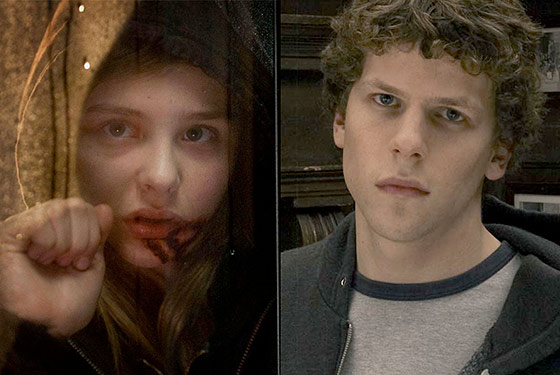
In retrospect, maybe it wasnÔÇÖt the best idea to release Let Me In this weekend. On the one hand, the underperforming Matt Reeves vampire drama might have seemed like clever counterprogramming to weekend winner The Social Network, but underneath the surface, the two films had quite a bit in common: Both of them were dark, self-assured tales of maladjusted (and often malevolent) youths yearning for a connection.
Oh, and they both had some moments of terrible CG, in the year 2010.
You might not expect bad special effects from Social Network director David Fincher, whos one of the savviest manipulators of computer graphics in the business  and yet! On its face, Social Network hews most closely to Finchers Zodiac, in that they both appear to be classically shot dramas with a minimum of flashy Fincher moments (except for midpoint virtuoso sequences  the tilt-shifted Henley Royal Regatta race in Social Network and the fast-motion assembling of the Transamerica building in Zodiac  that scream, Look, I had to do something), but when you see just how much blue-screen Fincher used in Zodiac, or learn that to create the Winklevoss twins in Social Network he pasted one actors head on anothers, it becomes apparent that this is a director who can find a way to sneak special effects into any story.
Ironically, for all the big things that FincherÔÇÖs FX team nailed in Social Network, it was something very small that tripped them up: the CG cold breath that was very obviously added in postproduction whenever the characters spoke to each other outside on chilly Harvard nights. Ostentatiously visible and swirly, it proved that facial-mapping features may have come a long way since the last decade, but the computer programs that generate plumes of cold breath havenÔÇÖt been revamped since Titanic. A director with fewer resources at his disposal might have eschewed the effect entirely, shot on a colder soundstage, or had the actors swallow ice before delivering their lines, but Fincher is the type who thinks he can get anything in postproduction (and is only right to a point). The cold-breath effect is so weird and jarring that itÔÇÖs a relief when the setting moves to the warmer climes of Palo Alto, since thereÔÇÖs no threat there of Jesse Eisenberg being upstaged by his own breath.
Let Me In is unsettling in a similar way: ItÔÇÖs so impressively grounded and well-made that its bad FX moments stand out all the more. The best asset at the filmÔÇÖs disposal is its child actors, Chloe Moretz and Kodi Smit-McPhee, and whenever Reeves is on a close-up of either, Let Me In sings. The problem comes during the movieÔÇÖs bursts of violence: While theyÔÇÖre all the more powerful for happening so rarely, they are also terribly animated. Suddenly, the very natural Moretz becomes an unnatural CG monster straight out of Species with a computer-aided scamper attack that tears at the compelling reality Reeves has set up. Much better is a later scene when youÔÇÖre left to imagine one of her attacks from the other side of a bathroom door: What you canÔÇÖt see is always more effective than what you can, but that goes double when what youÔÇÖd be seeing is a herky-jerky CG animation.
The Social Network and Let Me In are supremely confident works, so smoothly made that you hardly notice how each frame has been fussed over and color-corrected, and with both movies, you get the sense that what you see is exactly what the filmmaker intended ÔÇö that even if a stray hair went out of place, it could be zapped in post. That can be a powerful thing when done right (after a summer season of slipshod moviemaking, itÔÇÖs nice to give yourself over to someone who knows what heÔÇÖs doing), but an over-reliance on special effects shouldnÔÇÖt squeeze out something that might be better if done practically. WeÔÇÖve reached a watershed moment in cutting-edge filmmaking, but if given the choice, wouldnÔÇÖt you rather have movie magic happen on the set instead of in a computer?

